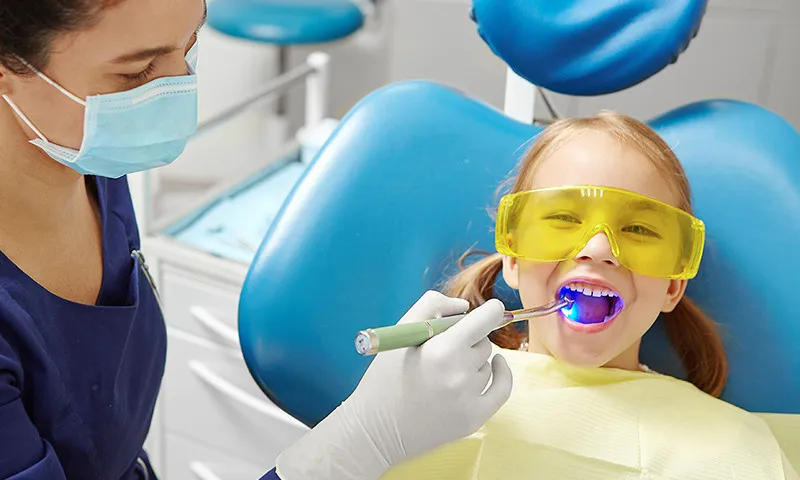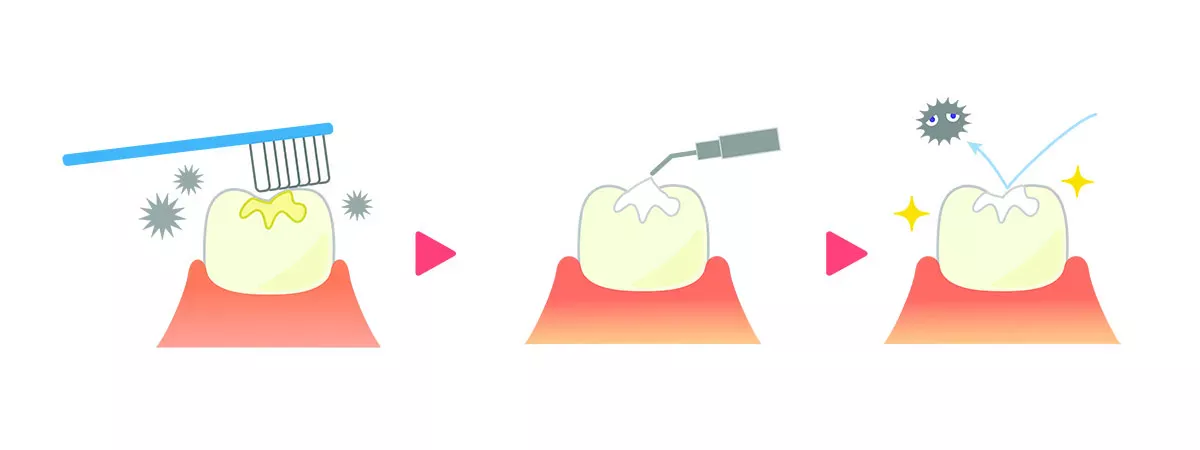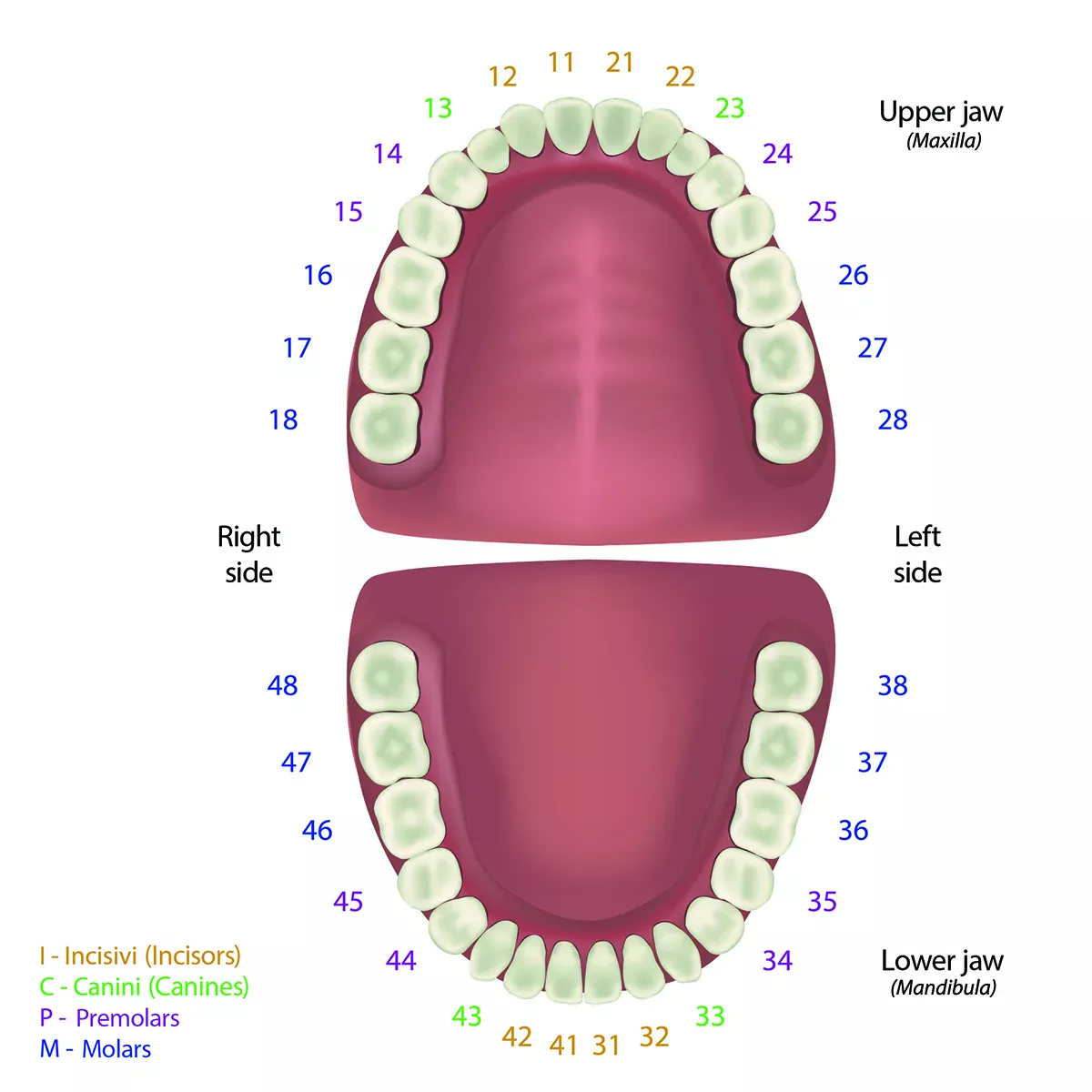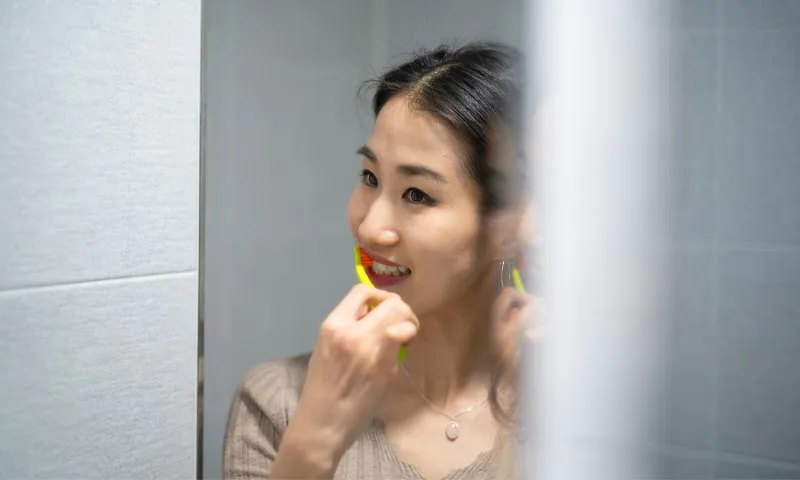Dental sealant: What is it?
The chewing surfaces of our molars resemble a mountainous landscape with peaks and valleys. These pits and furrows, also known as fissures in technical jargon, are real breeding grounds for bacteria and in some cases cannot be reached with a toothbrush, even with good oral hygiene. This can quickly lead to deposits of plaque and food debris. The result: bacteria can spread undisturbed. Caries develops.
To prevent this, dentists can fill the fissures with a liquid plastic that dries out on the tooth and fills the gaps - as if filling the valley. This creates a smoother chewing surface that can be easily cleaned with a toothbrush. This is also referred to as fissure sealing. The resin is usually white or transparent and therefore barely visible. Teeth can also be sealed with glass ionomer cement.
In the graphic you can see a before and after illustration: Before the dental sealant, the fissures are the ideal habitat for bacteria; after the sealant, they can no longer find a foothold there.
In addition to normal tooth sealing, there is also extended tooth sealing. In this case, caries has already developed on the surface of the tooth enamel in a fissure. The dentist can remove caries from the affected area and then fill it with liquid plastic. This treatment measure is intended to prevent recurrence.
Difference to fluoridation
Sometimes the application of a fluoride varnish at the dentist is also called a sealant. This varnish is mainly used after professional teeth cleaning and is intended to desensitise the teeth and strengthen the enamel. A fluoride varnish seal does not last permanently and must be renewed about twice a year. This measure is also intended to protect against tooth decay. However, the following is about sealing the fissures with plastic or glass ionomer cement.
Dental sealants for children: Yes or no?
Most dentists recommend dental sealants for children - as soon as possible after the permanent teeth have erupted. However, if there are no deep grooves and the child has good brushing behaviour and normal saliva flow, the teeth do not necessarily need to be sealed.
The following factors determine whether a dental sealant is advisable for your child:
- Anatomy: Are there deep grooves in the molars?
- Oral hygiene: Is the child negligent when brushing their teeth?
- Diet: Does the child frequently consume caries-promoting foods such as sweets or soft drinks?
- Caries risk: Has the child already had caries on other teeth?
If the answer to at least one of these questions is yes, a dental sealant makes sense.
Which teeth are sealed and when?
As a rule, children's permanent molars are sealed when they have fully erupted. Exactly when this happens varies from child to child. The permanent molars normally erupt around the age of six and push in behind the last milk teeth.
Dentists usually recommend sealing the large molars because they are often particularly fissured. These are the two rearmost molars before the wisdom teeth. If there is an increased risk of caries or the backs of the teeth have deep grooves, the small molars, canines and incisors can also be sealed.
Are dental sealants also available for milk teeth?
Milk teeth are not usually sealed. However, sealing may be necessary in rare cases if a child develops caries at an early age or has very deep grooves in the milk teeth.
Sealant before fixed braces?
In addition to sealing the fissures, it is also possible to seal the smooth surfaces of the front of the teeth. This is particularly useful before using fixed braces because the brackets make brushing teeth very difficult and have often caused carious discolouration in the past. To prevent this, a special varnish can be applied to the tooth surfaces after bonding the brackets and before inserting the splints, which then hardens. This additional protective layer is intended to prevent demineralisation - and therefore also caries and discolouration.
Dental sealants for adults
Adults can also have their teeth sealed. However, this is done much less frequently. The reason for this is that caries tends to form in the spaces between the teeth rather than in the fissures in adulthood. Fissure sealants are therefore more likely to be used in exceptional situations in adults - for example, if dental care is restricted due to a disability or the risk of tooth decay is increased due to permanent dry mouth.
Dentists seal exposed tooth necks much more frequently in adults if they suffer from pain-sensitive teeth. If the gums recede due to dental disease or excessive scrubbing with a toothbrush, or if small holes form in the tooth enamel, nerve endings can be exposed, causing those affected to react very sensitively to hot, cold, sweet and sour foods. Sealing with a protective fluoride varnish or plastic suppresses the transmission of stimuli and thus alleviates the pain.
Good to know:
You can find out exactly why teeth become sensitive to pain and what you can do about it in our article:
Procedure: How are teeth sealed?
Important: Under no circumstances should you attempt to apply a dental sealant yourself at home ! As incorrect application can have serious consequences, you should definitely leave this to the professionals.
Investigation
Before the actual dental sealant can be applied, the dentist must first check whether the fissures are free of caries. Otherwise there is a risk that the bacteria will continue to multiply under the sealant and attack the tooth. In the case of deeper caries, a filling is the correct treatment method - in this case, however, the teeth cannot be sealed. As caries cannot always be recognised with the naked eye, the dentist can also take x-rays or illuminate the mouth with special lamps or laser light.
The dentist also examines the anatomy of the teeth and decides whether a sealant is necessary - this is particularly the case with deep fissures. To do this, the dentist takes a close look at the teeth using a mouth mirror. He can measure the depth of the fissures with a probe.
Good to know:
Every child knows that tooth decay is bad for your teeth. But do you know exactly what tooth decay is? You can find all the important information in our article:
Preparation
Before the resin material can be poured into the fissures, a few preparatory steps are required: First, the dentist or a dental professional cleans the chewing surfaces thoroughly with special equipment and also removes discolouration - for example with rotating brushes or powder blasting devices. The tooth must then be dried. The dentist uses a cotton wool roll to shield the tooth from saliva flow. A rubber dam can also be used - this is a special plastic or rubber material that is placed around the tooth and fixed in place with a clamp.
It is important that children play along and keep still. If saliva does get on the tooth, the sealing material cannot adhere properly. As soon as the tooth is dry, the dentist applies a mild acid to the dry tooth to slightly etch and roughen the surface so that the plastic can adhere better.
The sealing
Once everything is prepared, the dentist pours a thin layer of liquid plastic into the fissures, where the sealing material adapts precisely to the anatomy of the tooth. Depending on the material, the material either hardens itself or requires a special UV light that is directed straight at the tooth. This is followed by polishing to remove any remaining material. Finally, the dentist checks the occlusion and fluoridates the tooth.
How long does a dental sealant take?
Sealing the teeth takes about 15 to 30 minutes per tooth. Whether all four large molars are sealed in one session or several sessions are scheduled depends on how well the child co-operates.
How long should I not eat after a dental sealant treatment?
You should not eat anything for at least an hour after a dental sealant treatment.
Does a dental sealant hurt?
Teeth sealing does not cause any pain. Most children therefore have a positive experience. However, there are two things that children (and adults) may find unpleasant: Cotton rolls or rubber dams can cause gagging. Some dentists offer their patients homeopathic remedies for this.
In addition, if all four teeth are treated at the same time, a sealant can take quite a long time. Some children find it uncomfortable to keep their mouth open for so long.
How long does a dental sealant last?
It is not possible to make precise statements about the durability of dental sealants. However, experts estimate that they generally last seven to ten years. Sealants rarely chip off completely. It is more common for a part to chip off. However, this happens most frequently in the first six months. The first follow-up check should therefore be carried out promptly. In general, dental sealants should be checked regularly and repaired or replaced if necessary. The dentist checks whether the sealants are still intact during regular dental check-ups.
Costs: What does the health insurance fund pay?
In Germany, statutory health insurance providers such as AOK, TK, Barmer and DAK cover the sealing of the four large molars for patients aged 6 to 17 or 18. Patients with health insurance often have to pay for all other teeth and also the smooth surface sealant before fixed braces are fitted. However, there are differences between the various health insurance companies. For example, Barmer reimburses the costs of a one-off smooth surface sealant prior to the use of fixed braces approved by the health insurance company. It is best to find out directly from your health insurance company whether you are entitled to reimbursement.
Those with statutory health insurance must also pay for the sealing of tooth necks themselves. The cost of sealing is around 15 to 45 euros per tooth. If you have supplementary dental insurance or private insurance, you may be reimbursed depending on your tariff.
Advantages and disadvantages: How useful is a dental sealant?
Finally, let's take a look at the pros and cons of tooth sealing so that you can form your own opinion.
Pro: Why are teeth sealed?
In children, caries occurs most frequently in the fissures - according to various studies, 60 to 90 per cent of caries cases in young people under 14 are in the grooves of the large molars. It therefore makes sense to seal the teeth as early as possible before caries can even develop - especially if other teeth are already affected by caries.
According to the Fourth German Oral Health Study by the Institute of German Dentists, dental sealants have played a very important role in the prevention of tooth decay to date. Around three quarters of the children surveyed had at least one dental sealant. And it has paid off for them: the children with sealed teeth had only about half as many teeth with caries experience (average 0.6) as children without sealed teeth (average 1.1). The biggest advantage of sealing teeth is therefore the protection against fissure caries, while the enamel is even more susceptible to caries.
In addition, the surface of the chewing surfaces is easier to clean after tooth sealing.
Cons: Are there any disadvantages for children with dental sealants?
According to the German Society for Dental, Oral and Maxillofacial Medicine (DZGMK), parents need not worry about toxic materials and allergic reactions. According to the professional association, there have only been two cases of severe allergic reactions worldwide. The DZGMK also dispelled concerns regarding the use of plastics that would release monomers and formaldehyde: It is true that substances that are potentially harmful to health are indeed produced in the outermost layer when the plastic hardens. However, this layer is removed after curing and the quantities are so small that, according to the current state of research, there are no adverse health effects when used correctly.
The greatest danger with a dental sealant is therefore not that the material is unhealthy, but that the dentist makes a mistake: if the dentist overlooks caries during the examination and carries out the sealant anyway, the caries can spread further under the sealant. This can also happen if the sealant is not completely sealed and air is trapped. The sealant can then become partially or completely loose. However, these processing errors rarely occur nowadays.
Conclusion: Does the dental sealant offer complete protection against caries?
A dental sealant is not an invitation to take a more relaxed approach to brushing your teeth. In a study conducted by the University of Kiel and the University of Greifswald, researchers found that protection against tooth decay is only provided with low caries activity. In other words, dental sealants only provide protection in combination with other oral hygiene measures such as regular and thorough tooth brushing. With high caries activity, dental sealants even lead to more caries. One reason for this could be that children and parents were lulled into a false sense of security and assumed that thorough tooth brushing was no longer necessary.
The fact is: with or without sealant - thorough tooth brushing is a must! And parents are primarily responsible for this.
These are the most important pillars of oral hygiene for children:
- Brush your teeth three times a day - about three minutes each time
- Clean interdental spaces once a day
- Use a soft children's toothbrush (for example, the Kids toothbrush from Curaprox)
- Brush with fluoride toothpaste from the first tooth (for example with Curaprox children's toothpaste)
Good to know:
As children up to the age of around nine are not yet able to brush their teeth properly, parents should help out at least once a day and brush their offspring's teeth. You can find out exactly how to do this, what the right tooth brushing technique is for your child and which tips make everyday tooth brushing with children easier in our tooth brushing guide for children:
Sources
Beauchamp, Jean et al: Evidence-based clinical recommendations for the use of pit-and-fissure sealants: a report of the American Dental Association Council on Scientific Affairs, in: Journal of the American Dental Association. 2008.
Bodensee Implantat Zentrum: Tooth sealing - procedure, advantages and disadvantages of the treatment.
Christian-Albrechts-Universität zu Kiel: Does dental sealing make sense?
Cochrane: Dental sealants for the prevention of dental caries in permanent teeth.
Egner, Thorbjörn: Karius and Baktus: A story with colourful pictures, funny songs and sheet music. Bertelsmann. 1976.
Kassenzahnärztlichen Vereinigung and Zahnärztekammer Hamburg: Fissure sealing.
National Association of Statutory Health Insurance Dentists: Fissure sealing.
Orthodontists Gropiuspassagen: Smooth surface sealing.
Paediatric dental practice Juliana Gralla: Sealing of molars.
Lam, Phoebe PY et al: Fissure sealant in a nutshell. Evidence-based meta-evaluation of sealnat's effectiveness in caries prevention and arrest, in: Journal of Evidence Based Dental Practice. 2021.
Micheelis, Wolfgang et al. (complete editing): Fourth German Oral Health Study (DMS IV). Institute of German Dentists.
Orthodontic practice of Dr Anne-Kathrin Arnold: Sealing of the bracket environment.
Schäfer, Marian: Teeth sealing for children?, on: apothekenumschau.de.
All websites last accessed on 02/10/2023.
 Swiss premium oral care
Swiss premium oral care








